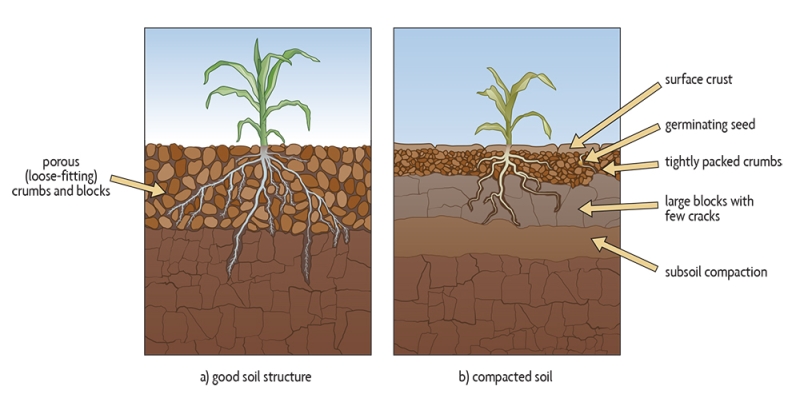
On the Importance of Dirt
Have you ever spent time on a farm or around farmers? Do you remember helping your parents weed their garden as a kid–or do you make your kids help you weed yours? Chances are, you’re connected to agriculture in some shape or form, even if it’s just through the food you eat.
Some issues with the U.S. industrialized agriculture system seem more or less obvious. Most people intuit that overfertilization and pesticide use can’t be good for the natural environment, even if they are unaware of the specifics of how nitrogen runoffs affect aquatic ecosystems. The average person has heard that consuming lots of red meat contributes to climate change, or that the atmosphere probably isn’t exactly thrilled about car emissions. Some issues, however, are less obvious to the average person for the simple reason that they don’t interact with it in their day-to-day lives, like they do cars and red meat. One of these issues is soil health. The catch is, people are dependent on soil health throughout their whole lives–they just don’t know it.
For most of my life, I thought of soil as not much more than a vessel for growing things. The things that grew from the soil, I thought, gave the soil its value. It took only a few weeks of living on a farm to show me how wrong I was.
The Importance of Soil
Soil isn’t just the vessel that holds plants–it is the foundation of all plant life, which means the foundation of our lives, too. When soil is healthy, erosion is reduced, water infiltration is maximized, and nutrient cycling is improved. It enables us to feed our population and sequester the carbon that badly needs sequestering in order to counteract the climate crisis. But not only is soil important–it is a highly dynamic living entity, which constitutes the greatest reservoir and donor of microbial diversity on Earth. Soil is in fact the Earth’s most biodiverse ecosystem, containing a third of all organisms.
But what makes soil healthy? Soil health is defined by the USDA Natural Resource Conservation Service as “the continued capacity of soil to function as a vital living ecosystem that sustains plants, animals, and humans.” Unfortunately, this measure of health can also be used as a measure of declining health–and at the moment, the latter category is much more obvious than the former. As microbial biotechnological scientists Kenneth Timmis and Juan Luis Ramos write, “As a result of anthropogenic abuses, and natural and global warming-promoted extreme weather events, Planet Earth is currently experiencing an unprecedented crisis of soil deterioration, desertification and erosive loss that increasingly prejudices the services it provides.” The main culprits of the severe soil degradation that has been unfolding over the decades is destructive farming practices, namely relentless tilling and disturbance from farm vehicles. This regular disturbance from machinery, and the disruption of soil’s natural ecological processes via tilling, leaves topsoil vulnerable to being whisked away by the elements.
Impacts of Tilling
Tillage has been used for centuries as an efficient way to churn weeds and crop residue back into the earth to prepare soil for the sowing of new seeds. In other words, it effectively kills off unwanted plant life to better ensure the productivity of the desired crop. It also allows for better mixing of fertilization, manure, or compost, and loosens the topsoil so the crop can more easily establish root systems. Particularly for large-scale agricultural operations, where tilling is seen as the most efficient method of preparing for planting, the process is considered essential.
The long-term consequences of tillage on soil health, however, could very well outweigh its benefits. According to Barb Stewart, state agronomist for USDA's Natural Resources Conservation Service (NRCS) in Iowa, even one-time, shallow tilling could affect the health and productivity of soil for years to come. While tilling is effective in killing unwanted plant life, it is also effective in disrupting soil’s natural structure, which provides the framework for good water infiltration, reduced runoff, and root development. It disturbs the habitats of microorganisms living in the top two inches of soil, who play an important role in nutrient cycling and helping decompose organic matter. Tillage also increases aeration in soil, which triggers increased biological productivity and subsequent rapid decomposition, loss of organic matter, and release of CO2 into the atmosphere. Aeration also makes soil more susceptible to compaction, which limits runoff and root development. Since tillage is used to theoretically reduce compaction, but actually makes soil more susceptible to compaction in the long run, it doesn’t take too many rounds of tillage to make soil so compacted that it relies on tillage to be productive. Many pieces of land today are so used to tillage that to stop the process cold-turkey wouldn’t be effective–the soil has, at least in the short term, lost its capacity to build a healthy ecosystem because of all the disruption. Tillage is used so commonly and is so counterproductive to healthy soil that it is likely one of the main reasons behind global soil degradation.
Soil Degradation
The effects of soil degradation on agriculture are undeniable, and the consequent effects on the human population are as obvious as they are terrifying. The average topsoil depth in Iowa, which used to be touted as one of the most fertile pieces of land in the world, decreased from around 14-18 inches at the start of the 20th century to 6-8 inches by its end. A report from the BBC states “in just one spring in 2014, Iowa lost nearly 14 million tonnes of soil from its cropland in a series of storms, according to environmental groups.” And this, disconcertingly, is not an isolated or unusual case. According to the United Nations’ Food and Agricultural Organization (FAO), a third of the world’s soil is now moderately to highly degraded. With topsoil growing steadily thinner and less nutrient-rich, the amount and quality of food which that soil can sustain is decreasing just as steadily.
How to Retain Soil Health
The Adirondack region has long been tied to agriculture, both economically and in the personal lives of its inhabitants. Whether you own acres of land or just a small garden in your backyard, there are relatively simple steps you can take to ensure your soil is healthy. Four general rules of thumb are: minimizing soil disturbance, maximizing soil cover, maximizing biodiversity, and maximizing the presence of living roots.
Minimizing soil disturbance is important to protect the microbial life in soil, and allow the natural structure of soil to provide a framework for water infiltration, runoff, and root growth. No-till farming is one of the most effective ways to minimize soil disturbance. In the place of tillage, to stop the growth of weeds, grass, and other unwanted plant life, you can place tarps, newspaper, burlap, or cover crops on unused plots of land.
Maximizing soil cover through cover crops is an effective way to fix nutrients into the soil, increase organic matter levels, and reduce erosion. This can also be done through alley cropping, where trees or shrubs are planted in rows within other crops.
Maximizing biodiversity can increase the amount of pollinators you attract and improve resilience against pests and diseases. Maximizing the presence of living roots, which can also be done through the use of cover crops, helps hold the soil in place and prevent erosion.
Changing your agricultural practices to prioritize soil health requires a holistic perspective of how the ecosystem functions. Through understanding the biodiversity in soil and taking steps to reduce disturbance through no-till and build up organic matter through crop cover, you can help the soil to regulate itself. When we shift the way we view agriculture from producing a crop to facilitating a healthy ecosystem where living things can thrive, we naturally move towards less destructive methods.
Building healthy soil up to maximum health and productivity can take years, but the practice of farming intentionally to improve soil health certainly isn’t new. Indigenous people’s traditional farming practices, such as crop rotations, polyculture, and agroforestry, have been preserving soil health for thousands of years around the world. These farming practices are based around the idea of working with the ecosystem instead of trying to control it.
Today, we are experiencing what has been accurately dubbed as a “soil crisis.” The deterioration of soil around the globe has severe consequences on food production, and action needs to be taken to change destructive agricultural practices towards conservation of soil. All around the world, scientists and farmers are working against these destructive practices and educating people on how to manage soil responsibly. No matter the scale of your land, you can take steps to protect and promote the health of the soil you have.

